|
|
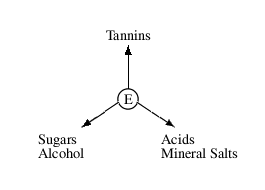 |
|
Balance in Red Wines |
|
The best way to understand red wines, just like any other style of wine, is to
personally evaluate them by means of one's own senses. The practical
application that we are going to suggest for red wines allow the evaluation of
the many organoleptic characteristics and, in particular, how the presence of
the many element can influence balance. In order to try the practical
application we suggest, it is required to have three wines: a plain Cabernet
Sauvignon produced in Friuli Venezia Giulia (Italy), a Merlot having two or
three years of aging in bottle as well as aged in barrique, possibly produced
in Tuscany (Italy) or California (USA), and a Pinot Noir aged for two or three
years and produced in Bourgogne (France) or in Alto Adige (Italy).
The appearance of the three wines shows rather different intensities and
colors. Pinot Noir will be one having the lighter color of them all and will
show a higher transparency, whereas Cabernet Sauvignon and Merlot will both
have colors and nuances practically similar. The first information that can be
determined by these observations is that Pinot Noir has a lesser coloring
capacity, that is contains a little quantity of pigments, as opposed to the
other two grapes, however this does not mean it produces low quality wines,
indeed, Pinot Noir is considered among the great grapes capable of producing
high quality wines. This initial evaluation should help in suppressing the
prejudice that wines having light colors are usually not very good, provided
they are produced with quality production criteria. Even at the nose the three
wines will offer different aromas. In Pinot Noir will be perceived aromas of
cherry, raspberry, red currant and strawberry, as well as aromas of vanilla as
a sign of the probable aging in cask. Merlot's aromas will probably be rather
different. In this wine will be perceived, first of all, aromas of vanilla and
oak because of the aging in cask, however it will be possible to perceive clear
aromas of black cherry, blueberry, plum, probably aromas of blackberry, as well
as aromas of jams and violet. In Cabernet Sauvignon will emerge an aroma that
could be pretty surprising and that would not be expected to be found in a
wine: the aroma of green bell pepper. This “curious” aroma will not probably
be the dominant one, however it will be clearly recognizable among other good
aromas of black currant, blueberry, black cherry and, more likely to be, even
eucalyptus. Lastly, it could be perceived, also in this wine, an aroma of
vanilla, sign of the aging in cask.
Even in the mouth the wines will taste differently. Pinot Noir will seem to be
more crisp, that is more acid, if compared to the other two wines, and its
astringency, produced by tannins, will be pretty low. Merlot will certainly
have a lower acidity, however a higher astringency will be perceived, even
though smooth and pleasing, produced by tannins. Merlot will seem to have a
greater structure and more body as opposed to Pinot Noir. Lastly, Cabernet
Sauvignon will have an even greater astringency if compared to the other two
wines, a sensation of astringency more aggressive and less smooth, and a good
body. It should be considered that quantity of alcohol will probably be the
same in all the three wines, probably from 12 to 13 percent of alcohol by
volume, however the wines, although having different levels of astringency,
will be balanced. In Pinot Noir, having a low astringency, balance is obtained
thanks to the higher quantity of acid whereas in the other two wines acidity is
lower while the astringency is higher.
|
Score legend
 Fair Fair   Pretty Good Pretty Good    Good Good
    Very Good Very Good      Excellent Excellent
 Wine that excels in its category Wine that excels in its category
Prices are to be considered as indicative. Prices may vary according to the country
or the shop where wines are bought
|

|
Barbera del Monferrato Rossad'Ocra 2000 |
| Cascina Maddalena (Italy) |
| Grapes: Barbera |
| Price: € 13,00 |
Score:    |
| The wine shows an intense ruby red color and nuances of ruby red, moderate
transparency. The nose reveals intense aromas of fruit, in particular
black cherry, blueberry, blackberry, plum, violet and hints of vanilla. In
mouth is correspondent to the nose, has a crisp attack balanced by tannins
and alcohol, good body and intense flavors. The finish is persistent with
flavors of black cherry and blueberry. Rossad'Ocra is aged in barrique for
about 12 months. |
| Food Match: Roasted meat, Braised meat with mushrooms, Hard cheese |
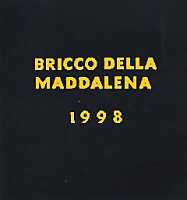
|
Monferrato Rosso Bricco della Maddalena 1998 |
| Cascina Maddalena (Italy) |
| Grapes: Barbera |
| Price: € 25,00 |
Score:     |
| The wine shows a brilliant ruby red color and nuances of ruby red,
moderate transparency. The nose reveals clean and intense aromas, mainly
of fruit, such as black cherry, blueberry and plum followed by aromas of
violet cinchona, pine tree, licorice and vanilla. In mouth has good
correspondence to the nose, a crisp and tannic attack however balanced by
alcohol, present in good quantities. Good body and intense flavors. The
finish is persistent with good flavors of black cherry and plum. This wine
is aged in barrique for 12-15 months. |
| Food Match: Game, Braised and stewed meat with mushrooms, Hard cheese |

|
Grechetto dei Colli Martani Terre di San Nicola 2001 |
| Di Filippo (Italy) |
| Grapes: Grechetto |
| Price: € 4,60 |
Score:     |
| The wine shows a light straw yellow and nuances of straw yellow, very
transparent. The nose reveals intense, clean and pleasing aromas of
pineapple, banana, hawthorn, jasmine, lemon, apple, hazelnut, pear and
peach. In mouth has good correspondence to the nose, a pleasing crisp
attack however well balanced by alcohol. Intense and very agreeable. The
finish is persistent with pleasing flavors of pear, lemon and apple. This
Grechetto is aged in steel tanks. |
| Food Match: Boiled fish, Crustaceans, Pasta and risotto with vegetables and fish, Sauteed meat, Appetizers |

|
Colli Martani Sangiovese Riserva Properzio 1999 |
| Di Filippo (Italy) |
| Grapes: Sangiovese |
| Price: € 5,80 |
Score:     |
| The wine shows an intense ruby red color and nuances of ruby red, moderate
transparency. The nose reveals refined, clean, intense and pleasing aromas
of black cherry, blueberry, plum, violet, carob, licorice and vanilla. In
mouth has a tannic attack however balanced by alcohol, good correspondence
to the nose, intense flavors and good body. The finish is persistent with
good flavors of plum, black cherry and blueberry. A well made wine which
will give its best within 2 years, however it is already drinkable.
Properzio is aged in barrique. |
| Food Match: Game, Broiled meat and barbecue, Roasted meat, Hard cheese |
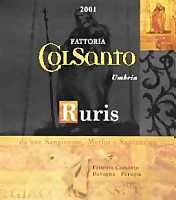
|
Ruris 2001 |
| Fattoria Colsanto (Italy) |
| Grapes: Sangiovese, Merlot, Sagrantino |
| Price: € 8,00 |
Score:     |
| The wine shows a brilliant ruby red color and nuances of garnet red,
moderate transparency. The nose reveals intense, clean and elegant aromas,
mainly of fruit, such as black cherry, blueberry, blackberry, plum and black
currant followed by good aromas of vanilla, caramel and cocoa as well as
hints of green bell pepper. In mouth has good correspondence to the nose, a
slightly tannic attack however well balanced by alcohol, good body and
intense flavors. The finish is persistent with good flavors of black
cherry, plum and blueberry. Ruris is aged for 10 months in barrique. |
| Food Match: Roasted meat, Hard cheese, Stuffed pasta |
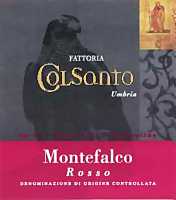
|
Montefalco Rosso 2001 |
| Fattoria Colsanto (Italy) |
| Grapes: Sangiovese, Sagrantino |
| Price: € 9,00 |
Score:     |
| The wine shows a brilliant ruby red color and nuances of ruby red, moderate
transparency. The nose denotes intense, pleasing and clean aromas, mainly
of fruit, such as black cherry, raspberry, blueberry, blackberry and violet
followed by pleasing aromas of vanilla, licorice as well as hints of
coffee. In mouth reveals good correspondence to the nose, a slightly tannic
attack however well balanced by alcohol, good body and intense flavors. The
finish is persistent with flavors of black cherry, blackberry and plum.
This wine is aged for 15 months in barrique followed by 3 months of aging
in bottle. |
| Food Match: Roasted meat, Stewed meat, Hard cheese, Stuffed pasta |
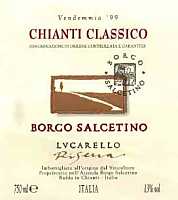
|
Chianti Classico Lucarello Riserva 1999 |
| Borgo Salcetino (Italy) |
| Grapes: Sangiovese, Canaiolo Nero |
| Price: € 13,00 |
Score:     |
| The wine shows an intense ruby red color and nuances of ruby red, moderate
transparency. The nose reveals pleasing, intense and elegant aromas, mainly
of fruit, such as black cherry, raspberry, blueberry, blackberry and plum
followed by intense and good aromas of violet and vanilla as well as hints
of chocolate. In mouth is round and pleasing, very balanced, with smooth
tannins and good body, intense flavors and good correspondence to the nose.
The finish is persistent with pleasing and clean flavors of black cherry,
blueberry and plum. A well made wine. This Chianti reserve is aged in
barrique followed by a long period of aging in bottle. |
| Food Match: Braised meat with mushrooms, Roasted meat, Broiled meat and barbecue, Hard cheese |
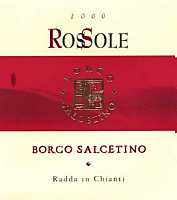
|
RosSole 2000 |
| Borgo Salcetino (Italy) |
| Grapes: Sangiovese (70%), Merlot (30%) |
| Price: € 10,40 |
Score:     |
| The wine has an intense ruby red color and nuances of ruby red, little
transparency. The nose reveals good personality with intense, clean,
elegant and refined aromas of black cherry, blackberry, plum and black
currant followed by good aromas of vanilla, licorice and cocoa as well as
hints of menthol. In mouth is elegant and round, with pleasing tannins and
good correspondence to the nose, good balance, intense flavors and good
body. The finish is persistent with good flavors of black currant, black
cherry and plum. A well made wine. RosSole is aged in barrique for 14
months followed by a long period of aging in bottle. |
| Food Match: Braised meat, Roasted meat, Broiled meat and barbecue, Hard cheese, Game |
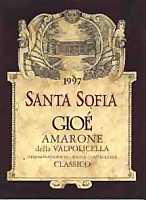
|
Amarone della Valpolicella Classico Gioé 1997 |
| Santa Sofia (Italy) |
| Grapes: Corvina (65%), Rondinella (30%), Molinara (5%) |
| Price: € 35,00 |
Score:      |
| The wine shows an intense ruby red color and nuances of garnet red, little
transparency. The nose reveals personality with elegant, intense, clean
and refined aromas mainly of jams. There can be perceived good aromas of
black cherry jam, blackberry jam and plum jam followed by pleasing and
clean aromas of black cherry macerated in alcohol, cocoa, caramel,
leather, licorice, enamel, violet and vanilla. In mouth has a tannic
attack which is well balanced by alcohol, excellent correspondence to the
nose, intense flavors and full body. The finish is persistent with
pleasing and clean flavors of blackberry jam, black cherry jam and plum
jam. A very well made wine. Amarone Gioé is produced in limited quantities
and only in particularly favorable vintages and ages for 48 months in cask
and 8-12 months in bottle. |
| Food Match: Roasted meat, Hard cheese, Game, Braised meat, Stewed meat |
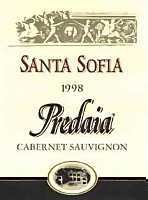
|
Predaia 1998 |
| Santa Sofia (Italy) |
| Grapes: Cabernet Sauvignon (85%), Corvina and Rondinella (15%) |
| Price: € 12,50 |
Score:     |
| The wine has a brilliant ruby red color and nuances of garnet red, moderate
transparency. The note denotes good personality with elegant, intense,
clean and refined aromas of black cherry, blueberry, bell pepper, plum,
black currant and violet followed by good aromas of vanilla, toasted,
caramel and chocolate. In mouth is round, agreeable and balanced, with good
correspondence to the nose, smooth tannins, intense flavors and good body.
The finish is persistent with clean and pleasing flavors of plum, blueberry
and black cherry. A well made wine. Predaia is aged for 12 months in
barrique and for 24 months in cask followed by 8-12 months of aging in
bottle. |
| Food Match: Roasted meat, Stewed meat, Braised meat, Game, Hard cheese |
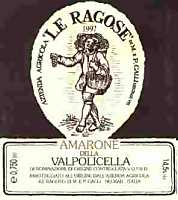
|
Amarone della Valpolicella Classico 1997 |
| Le Ragose (Italy) |
| Grapes: Corvina (50%), Rondinella (20%), Molinara (20%), other grapes (10%) |
| Price: € 23,00 |
Score:     |
| The wine shows an intense ruby red color and nuances of garnet red, little
transparency. The nose denotes intense, clean and elegant aromas such as
black cherry jam, blackberry jam, plum and dried violet followed by
caramel, white pepper, cocoa, walnut and vanilla. In mouth reveals good
correspondence to the nose, a tannic attack well balanced by alcohol,
intense flavors and full body. The finish is persistent with pleasing
flavors of plum, blackberry jam and black cherry jam. This wine is aged
for 12 months in steel tanks followed by 4-5 years of aging in cask. |
| Food Match: Roasted meat, Hard cheese, Game, Braised meat, Stewed meat |
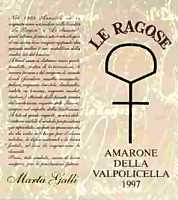
|
Amarone della Valpolicella Classico Marta Galli 1997 |
| Le Ragose (Italy) |
| Grapes: Corvina (50%), Rondinella (20%), Cabernet (5%), other grapes (25%) |
| Price: € 28,50 |
Score:      |
| The wine shows an intense ruby red color and nuances of garnet red, little
transparency. The nose reveals personality with pleasing, clean, intense
and elegant aromas, in particular of jams, such as black cherry jam,
cherry jam, strawberry jam and blackberry jam followed by intense and
clean aromas of black cherry macerated in alcohol, caramel, chocolate,
plum, dried violet and vanilla. In mouth denotes good correspondence to
the nose, a tannin attack well balanced by alcohol, intense flavors and
full body. The finish is persistent with clean flavors of blackberry jam,
cherry jam and plum. A very well made wine. This Amarone is aged for 3
months in steel tanks and for 2 years in cask followed by an aging in
bottle for at least one year. |
| Food Match: Roasted meat, Hard cheese, Game, Braised meat, Stewed meat |
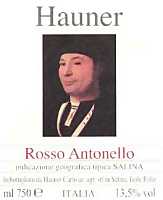
|
Rosso Antonello 1999 |
| Carlo Hauner (Italy) |
| Grapes: Calabrese, Sangiovese, Corinto Nero |
| Price: € 13,20 |
Score:     |
| The wine shows a brilliant ruby red color and nuances of garnet red,
moderate transparency. The nose reveals clean, intense and elegant aromas,
mainly of fruit, such as black cherry, blueberry, blackberry, plum and
carob followed by good aromas of dried rose, violet, cocoa and vanilla. In
mouth had good correspondence to the nose, good balance, intense flavors
and good body. The finish is persistent with pleasing and clean flavors of
black cherry and plum. Rosso Antonello is aged in barrique followed by 9
months of aging in bottle. |
| Food Match: Roasted meat, Broiled meat and barbecue, Hard cheese, Braised meat |
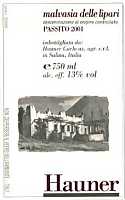
|
Malvasia delle Lipari Passito 2001 |
| Carlo Hauner (Italy) |
| Grapes: Malvasia delle Lipari (95%), Corinto Nero (5%) |
| Price: € 18,00 (500ml - 16.9 fl.oz.Confectionery, Dried fruit tarts especially of almonds, Hard and piquant cheese |
Score:      |
| Simply a great wine. It shows a beautiful and brilliant amber yellow color
and nuances of golden yellow, very transparent. The nose reveals great
personality with intense, elegant, refined, rich and pleasing aromas of
apricot jam, peach jam, candied fruit, date, dried fig, dried flowers,
almond, orange marmalade, honey, hazelnut, citrus fruit peel followed by a
pleasing hint of rosemary. In mouth is rich and charming, adequate
sweetness, smooth and round with intense flavors, very balanced. Excellent
correspondence to the nose. The finish is very persistent with pleasing and
long flavors of apricot, peach, honey, citrus fruit peel and candied fruit.
A truly well made wine, extraordinary also when tasted alone. This Malvasia
delle Lipari is produced with late harvested grapes which are subsequently
dried on mats. The wine ages for 18 months and for 6 months in bottle. |
| Food Match: Confectionery, Dried fruit tarts especially of almonds, Hard and piquant cheese |
|
Falerno, a prestigious wine, very renowned during the times of ancient
Rome, has always been of interests for researchers of the history of enology,
praised and appreciated in ancient times, for a long period it seemed to be
practically disappeared from the wine scene while being bound to his
prestigious fame, almost a legend, of the great times when it had a magnificent
splendor. Falerno sets its roots in classic ancient times. During those times
it was a wine very appreciated and Pliny the Elder believed it had therapeutic
qualities, it was considered by Horace his preferred wine, as well as by Virgil
that in the second book of The Georgics wrote «Nec cellis ideo
contende Falernis» (therefore no wine can be compared to Falerno). Many other
illustrious people of the Roman times praised the qualities and the nobility of
Falerno, whose maximum spreading was promoted during Julius Caesar's times. In
recent times it was appreciated by Russia's Zar and it was the preferred wine
at the court of King Gustave of Sweden and it also became the official wine of
the Palace.
|
| 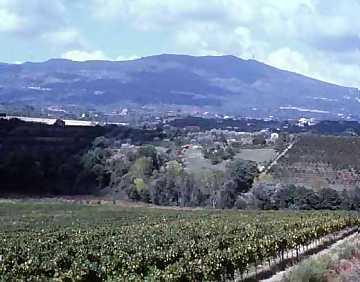 |
| A view from Villa Matilde's vineyards |
|
After having lived a flourishing period of splendor and fame, which continued
until the end of the 1800's, the production of Falerno suddenly stopped for
more than half a century because of the terrible devastations of phylloxera
which destroyed 95% of vineyards. To the catastrophical events of phylloxera
survived few vines which subsequently formed the raw material to which Falerno
would have been reborn thanks to the passion of a Neapolitan lawyer, Francesco
Paolo Avallone, father of Salvatore and Maria Ida, current proprietors of Villa
Matilde, that in his youth was assistant of Roman Law at the University of
Naples and in his studies, done in books written by great classical authors, he
often found mentions and praises for this great wine. Fascinated by the written
witnesses found in the great classical books about Falerno wine, about 45 years
ago, lawyer Francesco Paolo Avallone decided that we would have tried to revive
this legendary wine. Lawyer Avallone began his studies and, with the help of
some researchers of the Agricultural University of Naples, he started a project
whose aim was to find out the proper characteristics of the grapes used in
Roman times for the production of Falerno, by deducting them from the books of
Pliny, Catullus, Columella and all the other authors that directly or
indirectly left witnesses useful to the definition of the grape species to be
used.
As a result of these preliminary researches they started investigating about
the ancient lands of Falerno, in particular the area of “Massico”, in order
to verify whether there still were grapes having the requisites emerged by the
researches. At the end of these investigations they found the vines to be used
and they exactly found 20 vines having the requisites they were looking for: 10
were of Aglianico, that is the ancient Hellenico grape, a vine
introduced in the colonies of ancient south Italy by Greeks, 5 of Piedirosso,
(literally “red foot”), so called because of the characteristic color of the
stem; two variety of grapes that opportunely vinified and aged would have
produced red Falerno, and 5 of Falanghina, the grape used to produce white
Falerno, the famous Vinum Album Phalanginum mentioned in the books of
the renowned Medical School of Salerno. It seems that Falerno name derived from
the deformation of term Phalanginum into Phalernium; therefore it
is probably that the original Falerno wine was white.
By using these few survived vines as a base material on which reviving the fame
of Falerno, it was conducted a patient work on reproduction done by experts
that allowed to save and propagating those few and precious survived vines and
that were saved from the devastations of phylloxera. The vines from which the
needed material for the reproduction was to be used, were scrupulously selected
and grafted in sprouts resistant to phylloxera and then, little by little, they
were successful in replanting the vineyards in the hills of Ager
Falernus that produced for many centuries not particularly abundant harvest
but of the best quality. The original plants are still kept at Villa Matilde
winery and every time it is needed to plant new sprouts, the vines used for the
propagation are directly taken from that old vineyard. Thus, after more than a
century of absence, the first bottles of Falerno got again their way to the
tables of connoisseurs.
The current production of Villa Matilde, besides including the “Falerno del
Massico” wines, also offers other wines, both white and red, produced with
local grapes. Falerno del Massico is produced as white and red by using the
ancient grape composition, faithful to the historical tradition of these wines.
The white is exclusively produced with Falanghina, whereas the red, of which is
also produced in the best years only a reserve as well, is obtained by
Aglianico and Piedirosso grapes. With the very same grapes are also produced
three “mono varietal” wines.
|
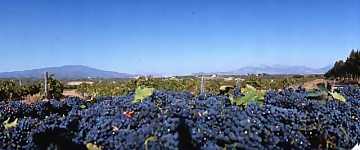 | |
| A vineyard of Villa Matilde | |
|
Concerning the production of white wines, there is “Tenuta Pietre Bianche”, a
young and crisp wine mainly produced with Falanghina and Coda di Volpe. The
“Falerno del Massico Vigna Caracci” is a white wine produced with Falanghina
grape harvested in a tiny vineyard of about three hectares (about 7.5 acres)
and located in the hills near the volcano of Roccamonfina. The grape is
harvested when it is fully ripe in order to exalt the aromatic characteristics
and the wine ages in barrique for about five months. Another white wine
produced by Villa Matilde is “Campostellato”, a particular reserve of
Falanghina produced with selected grapes from which is obtained a particularly
concentrated must, rich in aromas and acidity, that will be transformed in a
full bodied wine.
Talking about the production of red wines there is “Terre Cerase”, obtained
by Aglianico grape, and “Poggio alle More”, produced with Aglianico and Red
Coda di Volpe as well as other local grapes. Result of many years of selections
is “Vigna Camarato”, a wine produced with Aglianico grape harvested in the
vineyard having the same name, one of the oldest and best exposed vineyards in
the estate's hills, located at the base of the volcano of Roccamonfina. The
wine is aged in cask as well as in bottle for 18 months. Another interesting
red is “Cecubo”, produced with Piedirosso, Abbuoto and Primitivo grapes, aged
in cask. With dried Falanghina grapes, left on the plant until November, is
produced “Eleusi”, an excellent late vintage. After the grapes have
been harvested they are allowed to dry in mates under the sun and the must
which is obtained is subsequently fermented and aged in barrique for three
months followed by a long aging in bottle. The production of Villa Matilde is
completed by two grappas, both produced with Falanghina pomace, and olive oil
produced with olives harvested in the winery's estates.
|
Score legend
 Fair Fair   Pretty Good Pretty Good    Good Good
    Very Good Very Good      Excellent Excellent
 Wine that excels in its category Wine that excels in its category
Prices are to be considered as indicative. Prices may vary according to the country
or the shop where wines are bought
|
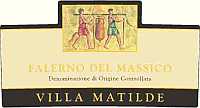
|
Falerno del Massico Bianco 2002 |
| Villa Matilde (Italy) |
| Grapes: Falanghina |
| Price: € 5,50 |
Score:     |
| The wine shows a firm greenish yellow color, very transparent. The nose
reveals elegant, refined and delicate aromas of acacia, pineapple, banana,
litchi, apple, hazelnut, pear and peach. In mouth has a pleasing crisp
attack however well balanced by alcohol, good correspondence to the nose,
intense and agreeable flavors. The finish is persistent with clean flavors
of pineapple, pear and banana. A well made wine. |
| Food Match: Boiled fish, Crustaceans, Pasta and risotto with vegetables and fish, Sauteed meat, Appetizers |
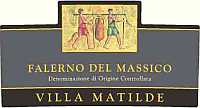
|
Falerno del Massico Rosso 2001 |
| Villa Matilde (Italy) |
| Grapes: Aglianico (80%), Piedirosso (20%) |
| Price: € 6,70 |
Score:     |
| The wine shows an intense ruby red color and nuances of ruby red, little
transparency. The nose has fruity, clean and intense aromas of black
cherry, raspberry, blueberry, plum, violet and vanilla. In mouth reveals
good correspondence to the nose and good balance. Intense flavors and good
body. The finish is persistent with good flavors of plum and black cherry.
This wine is aged in cask for 10-12 months. |
| Food Match: Meat with mushrooms, White roasted meat, Soft cheese, Stuffed pasta |
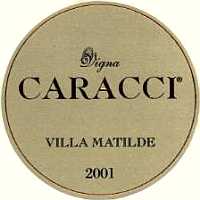
|
Falerno del Massico Vigna Caracci 2001 |
| Villa Matilde (Italy) |
| Grapes: Falanghina |
| Price: € 10,60 |
Score:     |
| The wine has an intense straw yellow color and nuances of straw
yellow, very transparent. The nose is elegant, refined and of
personality with aromas mainly of fruit and an agreeable hint of wood
aroma which does not disturb the perception of other aromas. There can
be perceived good and intense aromas of acacia, pineapple, banana,
broom, litchi, apple, hazelnut, pear, peach and vanilla. The mouth
denotes a pleasing crisp attack promptly balanced by alcohol and a
good correspondence to the nose. Good and intense flavors of fruit,
very elegant and pleasing. The finish is persistent with flavors of
peach, pineapple and pear. A well made and pleasing wine where the
typicality of the Falanghina grape is well recognizable. This wine is
produced by cold maceration and fermentation in barrique followed by a
5 months aging in barrique. |
| Food Match: Fish appetizers, Pasta and risotto with fish, Fish and crustaceans |
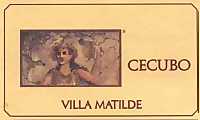
|
Cecubo 2000 |
| Villa Matilde (Italy) |
| Grapes: Abbuoto (45%), Primitivo (35%), Piedirosso (20%) |
| Price: € 11,20 |
Score:     |
| The wine shows a beautiful and deep ruby red color and nuances of purplish
red, little transparency. The nose is full of clean and intense aromas,
mainly of fruit, neat and pleasing. There can be perceived good aromas of
black cherry, cocoa, licorice, blueberry, plum, black currant, violet and
vanilla. In mouth reveals a tannic attack however well balanced by alcohol
and a good correspondence to the nose, intense. The finish is persistent
with pleasing flavors of black cherry, blueberry, licorice and plum. Cecubo
is aged in barrique for 12 months. |
| Food Match: Game, Roasted meat, Hard cheese, Braised meat, Stewed meat |
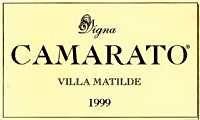
|
Falerno del Massico Vigna Camarato 1999 |
| Villa Matilde (Italy) |
| Grapes: Aglianico |
| Price: € 22,50 |
Score:      |
| The wine shows a deep ruby red color and nuances of ruby red, little
transparency. The nose reveals personality and elegant, refined, intense
and clean aromas such as black cherry, cherry macerated in alcohol,
chocolate, licorice, blueberry, black pepper, plum, violet and vanilla. In
mouth has a good correspondence to the nose, a slightly tannic attack
promptly balanced by alcohol, intense flavors and good body. The finish is
persistent with pleasing flavors of black cherry and plum. A well made
wine. Vigna Camarato is aged in barrique for 12 months and in bottle for
12 months. |
| Food Match: Game, Roasted meat, Hard cheese, Braised meat, Stewed meat |
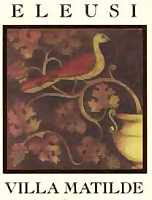
|
Eleusi Passito 2001 |
| Villa Matilde (Italy) |
| Grapes: Falanghina |
| Price: € 18,30 (500 ml) |
Score:      |
| The wine shows a beautiful and deep amber yellow color and nuances of
golden yellow, very transparent. The nose reveals great personality,
with elegant, refined and clean aromas. There can be perceived
intense and clean aromas of dried apricot, candies, caramel, quince
jam, dried fig, litchi, cooked apple, honey, hazelnut, nut and pear.
In the mouth denotes an excellent correspondence to the nose and a
pleasing crispness and sweetness which make this wine very balanced.
The finish is very persistent with long and pleasing flavors or dried
apricot, litchi, honey, dried fig and nut. A great wine. Eleusi is
produced with grapes left to dry on the vine until November and it is
fermented in barrique and aged in barrique for 3 months followed by a
long aging period in bottle. |
| Food Match: Hard and piquant cheese, confectionery, jam tarts |
|
This section is reserved to wine producers who want to publish news and
information about their business, to announce new products or just for
communicating to their customers information and promotions about their products
and activity. Send news to be published at our e-mail address.
|
|
In this section will be published news and information about events
concerning the world of wine and food. Whoever is interested in publishing this
kind of information can send us a mail at our address.
|
|
As the summer season is about to come, people's preferences move towards a
consumption of white wines and sparkling wines, while forgetting, like to say,
red wines until cold season will come again. In general terms, in the meals
consumed during warm seasons, foods are more simple and less elaborated, fish
and vegetables are preferred, dishes based on meat get less rich and lighter,
as well as sauces for pasta and rice. Even the preference for wines tends to
favor the fresher and lighter ones, easily drinkable, in particular, the ones
that can be served at lower temperatures, therefore white wines are the ones
mainly matched with foods in warm seasons. However there is a category of wines
that would be excellent in summertime, not only to be drunk alone, but also,
and particularly, matched to food: sparkling wines. The so called “bubbles”,
of which any wine producing country can offer a huge selection of styles, have
such characteristics as to be extremely versatile and adequate for summertime,
in particular with the dishes of this season, they are usually served at low
temperatures, a condition which is usually appreciated during hot days. The
versatility of these wines allows them to be excellently used in the
enogastronomical matching, no matter the season.
|
A Vast Selection of Products
|
Sparkling wines are now produced in every country of the world which produces
wine, the range of products available on the market is vast, with a broad
selection both of prices and styles. Among the wine producing countries of the
world, the ones that certainly have an important and fundamental role in the
enology “bubbles” scene, mainly because of quantity, and certainly for
quality as well, are France, Italy and Spain, including all the other countries
where modest quantities of sparkling wines are produced, such as Germany, South
Africa, Australia, United States of America and New Zealand, as well as other
countries of the world where some producers offer this type of wines.
France, the country which is mainly and easily associated to bubbles, offers a
vast selection with its Champagne available in different styles and
qualities, exclusively produced with the Méthode Champenoise, or classic
method of the refermentation in bottle. The vast selection of Champagne, from
extra-brut to sweet, from elegant Blanc de Blancs, exclusively
produced with Chardonnay grape, to the bodied Blanc de Noirs, produced
with Pinot Noir grape and sometimes Pinot Meunier, without forgetting about
Rosé, from the easy drinking, and surely interesting as well, Sans
Année, that is non vintage and produced with wines from many vintages, to the
elegant and rich vintage, make this wine very suitable to the
enogastronomical matching and it also allows the matching of a whole meal, from
aperitif to dessert, exclusively matched with Champagne. In France are also
produced other sparkling wines with the classic method and that come from areas
outside Champagne: Crémant. These sparkling wines, even though they are
less famous than Champagne, may offer excellent opportunities for
enogastronomical matching. Among these wines must be certainly mentioned
Crémant d'Alsace, Crémant de Die, Crémant de Bourgogne,
Crémant de Loire, Crémant de Limoux and Crémant de
Bordeaux. In Luxembourg, with the same name and with the same method, is
produced the Crémant de Luxembourg. Moreover in Gaillac, France, is
produced a sparkling wine by means of the Méthode Ancestrale, which is
called Gaillac Mousseux.
Italy offers a vast selection of sparkling wines and every region practically
produces its own, most of the times regulated by disciplinary of production
of the many DOCs (Denominazione d'Origine Controllata, Appellation of
Controlled Origin), such as, for example, Oltrepò Pavese and Trento.
Franciacorta certainly is to be considered among the best bubbles wines
of Italy, produced with the Metodo Franciacorta, not very different from
the classic method. These wines, according to an Italian law cannot be called
with the general term spumante but exclusively Franciacorta, are
available in a vast selection of types, different levels of sweetness, from the
extremely dry Non Dosato (or Pas Dosé, Dosage Zéro, Pas Opéré or
nature) to sweet Demi-Sec, from refined Satèn, exclusively
produced with Chardonnay and Pinot Blanc grapes, to the more bodied
Franciacortas where Pinot Noir grape is used as well, this style also includes
Rosé, from the Senza Annata, (non vintage), produced with wines
from different vintages, to the refined and important millesimati
(vintage). A vast and complete selection of types which allows, even in this
case, the possibility of matching a whole meal exclusively with Franciacorta.
Even Talento, produced in some northern regions of Italy, is an
interesting sparkling wine and they also come in different styles and are
produced with the classic method. Talentos, which usually come as
Extra-Brut or Brut and also produced in the riserva styles
as well as millesimati, offer excellent opportunities for the
enogastronomical matching. Another dry sparkling wine produced in Italy, famous
in every part of the world, is Prosecco di Valdobbiadene, mainly
obtained with the Prosecco grape, is a wine produced with the
Charmat method and it is available in many styles, usually dry, of which
the Superiore di Cartizze is the most renowned one. Even Prosecco offers
interesting possibilities for the enogastronomical matching. In Piedmont are
produced two sweet sparkling wines, famous everywhere, Asti spumante and
Brachetto d'Acqui. Asti spumante, or simply Asti, is produced
with Muscat Blanc grapes which give this wine a pleasing and strong
aromaticity, as well as its characteristic sweetness, make this wine
particularly suited for the matching of desserts. Brachetto d'Acqui, produced
with Brachetto grapes, fascinates for its light red color, as well as for its
strong aromas of rose and strawberry, as well as for its typical sweetness, it
is an excellent wine to be matched with desserts.
Even Spain offers a vast selection of sparkling wines with its Cava.
These wines are produced with the classic method and are available in different
levels of sweetness, from the extremely dry Brut Nature to the sweet
ones, as well as Rosé styles, produced both as non vintage and
vintage, as well as reserve. Even Cavas, thanks to the
many production styles, allow the matching of a whole meal. Other countries
that can offer sparkling wines, suited for the enogastronomical matching, are
Germany with its Sekt, a sparkling wine mainly obtained by
Riesling grape and generally produced with the Charmat method;
South Africa that offers good sparkling wines produced with the classic
method; United States of America, in particular California, with a production
of classic method sparkling wines, as well as Australia and New Zealand.
|
Matching with Food
|
Matching food with sparkling wine can be realized by means of the evaluation
and the consideration of two fundamental elements: glass in which wine is being
served and the specific organoleptic qualities of the sparkling wine. The glass
in which sparkling wine will be served must be chosen according to the type
and, in particular, to the method of production of the wine, as well as its
aromatic complexity. Sparkling wines produced with the Charmat method
are usually served in the demi-flûte, a glass not much tall and tight,
which will however allow the correct development of perlage, certainly
not as refined as the one of wines produced with the classic method. In case a
wine is produced with the long Charmat method, that is with a prolonged
production time as opposed to the normal production, the wine could have
developed more complex aromas and therefore they must be valued with a
flûte glass having a larger body. Non vintage classic method
sparkling wines will be served in a regular flûte, whereas the
vintages will be served in wide flûte, a particular glass having a
tight and stretched base and a wider body and opening in order to allow a
correct development of complex aromas of these wines. Sweet and aromatic
sparkling wines are the ones that will be served in the cup glass, short
and with a wide opening, in order to allow the appreciation of wine's
aromaticity as well as allowing the development of the more delicate aromas.
The matching of sparkling wines and food will consider the main characteristics
of these wines: effervescence and acidity, two factors that are particularly
perceived in the tasting of “bubbles” wines. Although these two
characteristics are the most dominant and perceptible ones during the first
impression the wine gives to the mouth, in sparkling wines will also be
considered the quantity of alcohol, its roundness, that is how it is
smooth to the mouth and, last but not the least, the level of sweetness.
It must be remembered a brut sparkling wine, even when it tastes dry,
can even contain as much as 15 grams of sugar and even though the sweet
perception will be greatly diminished because of carbon dioxide, it will
however contribute to wine's smoothness and roundness. Even body will be
important when considered for matching: sparkling wines exclusively produced
with white berried grapes, the so called Blanc de Blancs, will have a
lesser body, that is structure, when compared to the ones produced with both
white and red berried grapes, moreover Blanc de Noirs will have an even
greater body, and the body of Rosé will be even greater than that. Body
in a wine will be also determined by the aging period; in general terms
vintage wines will have a greater body and complexity when compared to
non vintage wines. The same is also true for the production method:
sparkling wines made with the classic method will be more structured
than the ones produced with the Charmat method. For these reasons,
Charmat sparkling wines usually precede classic method,
vintages comes after non vintages, Rosé will be served
after white sparkling wines. Even the level of sweetness is important in the
sequence of service; at the beginning will be served the most dry ones up to
the most sweet ones.
Effervescence in sparkling wines is particularly useful in the enogastronomical
matching of foods which tend to be sweet in taste, such as cereals, rich in
starch and therefore pasta and rice, vegetables and shellfishes, as well as
dishes being pretty fat or having fat seasonings or sauces. The same function
is also done by acidity, found in sparkling wines as well, therefore it must be
considered, in this case, that effervescence and acidity in these wines work
together perfectly contrasting sensations of fat tastes or slightly sweet
tastes in foods. According to these two “simple” rules we can set, in general
terms, that a good risotto with shellfishes can be matched with a
sparkling wine.
Alcohol will be useful in balancing the sensations of succulence, the
physiological reaction of salivation originated by foods rich in proteins, as
well as foods seasoned with unctuous ingredients, characteristics
usually found in meat, cheese and in some elaborated dishes of fish. Roundness
in a sparkling wine, determined by its level of sweetness, will be useful for
the matching of tasty foods as well as for ingredients that will tend to be
acid or bitter. The persistence of sparkling wines will be useful
in balancing those dishes having strong flavors as well as persistent, and the
body of the wine will be of help in balancing elaborated and complex dishes.
Finally, the clearly perceptible sweetness of some sparkling wines, such as
Asti and Brachetto, as well as sweet Champagne or demi-sec Franciacorta, will
be the perfect companion for desserts, in particular the ones prepared with
creams or desserts with ice creams.
As it can be seen, there are sufficient elements in order to “demolish”, at
last, the prejudice that sparkling wines are exclusively suited for moments of
celebrations and parties: their characteristics make them perfectly and
magnificently suitable for the enogastronomical matching, moreover, obeying to
the rules of the sequence of service for wines, it is certainly possible to
match a whole meal with bubbles only and the experience, try it to believe,
will be very exciting and rich in amazing surprises.
|
A Practical Example: Franciacorta
|
| 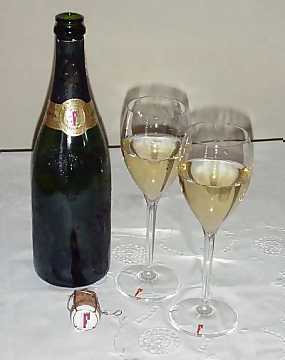 |
| Franciacorta, served in its glass
designed by the consortium, is an excellent companion in the enogastronomical
matching |
|
The best way to test the validity of a theory, no matter what, it is to confirm
it by means of a practical application. In order to prove the efficiency and
the versatility of bubbles in the enogastronomical matching, we will make use
of Franciacorta, thanks to the rich and vast availability of styles, it will
allow us to use it for matching very different dishes. The first aspect we will
consider is the type of glass to be used for this wine. The Consortium for the
Safeguarding of Franciacorta has designed a particular and efficient glass,
marked by the Franciacorta symbol, the unmistakable embattled letter “F”,
printed at the base of every glass. The wide and stretched body allows the
proper development and appreciation of perlage, whereas the rounded tulip shape
will allow an adequate development and appreciation of aromas; a glass that
certainly and rightly exalts the best characteristics of this excellent wine.
Franciacorta wines are available in many levels of sweetness and styles;
factors that allow this wine to be perfectly used for the matching of the many
dishes in a meal, from aperitif to dessert. Franciacorta Non
Dosato, the most dry one of them all, can be served as an excellent
aperitif, moreover, it can be matched to fish appetizers, vegetables and
cheese, shellfishes and crustaceans, as well as pasta and risotto with fish and
vegetables. Franciacorta Satèn, exclusively produced with white
berried grapes, thanks to its elegance and delicacy, can be served as aperitif,
or matched to appetizers and main courses made of fish and white meat, or with
vegetables pies. Franciacorta Brut, enriched in its structure
by Pinot Noir grape, is a good match for main courses made of fish and
vegetables, roasted and broiled fish, as well as dishes made of white meat, and
in particular the vintage, can be matched to red meat, roasted or
sauteed and, in case of particularly structured vintages, even to rich and
elaborated dishes made of meat. Lastly, this style of Franciacorta can be
matched with soft cheese as well as fatty cheese, such as robiola and
mozzarella, and fried foods, in particular, fried fish.
Franciacorta Rosé will be a good match for cold cuts, even
tasty, main courses made of meat and mushrooms, rich dishes made of vegetables,
such as parmigiana, roasted fish, rich and tasty fish and vegetables
soup, as well as dishes made of red meat. At the end of the meal,
Franciacorta Demi-Sec, thanks to its sweet taste, will
perfectly match a dessert with cream and fruit, as well as ice cream tarts.
Finally, we would like to end this short, but significative, list of examples
of enogastronomical matches with bubbles with another suggestion related to one
of the most famous dishes of the Italian cooking known everywhere in the world.
Did you ever think about matching Franciacorta Brut with a tempting pizza? This
colored and tasty dish is a joy of ingredients: the base, rich in starch,
therefore having a taste tending to sweet, will be well matched to the
effervescence and crispness, the other ingredients, such as tomatoes,
mozzarella, mushrooms, vegetables and cold cuts, common in many pizzas, will
have a loyal companion in the richness of these “bubbles”. Enjoy the meal!
|
Historical Facts
|
The etymological origin of coffee is uncertain. “Qahwah”, in the Arab
language, meant a dark beverage having stimulant and exciting effects,
sometimes also used as a medicine. It seems that with time “Qahwah” was
transformed into the Turkish term “Quahvè” whose meaning is coffee. Others
believe this word came from an Ethiopian region in which a plant similar to
coffee wildly grows up. However the exact scientific term is “Coffea
Arabica”. Even the origin of coffee itself is not certain. Just like other
plants, its spreading was a consequence of wars and colonizations and, in
particular, trading. Still today, some African people are used to dry the
coffee grains which are subsequently toasted and transformed into “breads” to
which salted butter is added, excellent to be consumed during the journeys.
Even Arab warriors consumed it because caffeine gave them courage and
aggressivity. It seems that coffee was known among monks in Yemen and goats,
which used to eat certain grains from an evergreen plant, subsequently became
nervous and sleepless. Monks thought of using the properties of these grains in
order to prolong their period of praying. The beverage started spreading with
the name of “Arab's wine”, among Egyptians first and then among Turks.
In the half of 1700's the plantations were mainly located in the tropical area,
therefore were French that, with their colonies, took the highest benefits from
the trading of the precious fruits. From 1800's on were the English to get
considerable commercial profits because of the trading of coffee. The profits
of the French, English, Spanish and Portuguese colonies moved the cultivation
area from tropical Asia to Latin America. In the half of 1600's coffee was
introduced in Europe and in particular to Marseille, Amsterdam, Paris and
London, where the first coffee shops were established. From 1720 to 1882 in
Italy were established 6 coffee shops. In 1727 they started new plantations in
Para, Brazil, and subsequently the cultivation of coffee spread all over the
country, sometimes replacing the plantations of sugar canes. The production
rapidly increased and at the beginning of 1900's, it could satisfy more than
50% of worldwide needs.
Consumption of coffee rapidly increased and at the beginning of 1800's in the
Martinica island were started new plantations which arrived to produce as much
as 20 millions plants of coffee: in a short time the activity of coffee planter
rapidly spread all over the islands of Antilles. From that moment on, slowly,
the “oriental” production will face a progressive decay. Currently south
America can satisfy almost 100% of worldwide production and Brasi is the first
country which produces the highest quantity, whereas Columbia ranks second for
quantity while being the first for quality. Another important country for the
production of coffee is Ivory Coast, important producer of Robusta quality. As
far as Arabic quality is concerned, among the largest producers are Costa Rica,
Guatemala, India, Vietnam, Yemen as well as others which complete the worldwide
scene of coffee production in the world.
It is said that after the defeat of Turks and after they were sent away from
Vienna, many sacks containing dark grains were found, never seen before, and
no one did not know how to use them. It is said that Mr. Kolschitzky, who lived
for a long time in Turkey, took the sacks and established the first coffee
shop. In the beginning that strange beverage, having a bitter taste, was not
pretty successful, but as honey and milk were added, it became a striking
success which is still continuing nowadays.
|
Consumption and Spreading
|
In Italy coffee were imported by Venetians around 1570, however it was the
Paduan Prospero Alpino the first one who introduced it from east. In the
beginning only rich people could afford the luxury of coffee, the beverage with
a very high price was sold in pharmacies only. After the first coffee shop was
established, other followed and coffee became a very appreciated beverage; in
1763 Venice had more than 200 shops where coffee was served. Lovers, instead of
giving roses to their fiancees, used to give trays of coffee and chocolate.
Coffee was also used as a corroborating and medicinal beverage and it was even
prescribed by some physicians.
The beverage was popular among Arab, Yemenite, Syrian and Egyptian people since
the fourteenth century, these people were used to drink coffee in order to
prolong the night vigil. In the fifteenth century there were public shops were
dense and bitter coffee was sold. However coffee did not have an easy life, it
was often banned by religious authorities because it made people desert
mosques, for this reason they started a propaganda against coffee in order not
to have their authority compromised. However this activity was not detrimental
to the spreading of coffee all over the country and the popularity was so high
that is was called “wine of Islam”.
In France coffee was introduced by some merchants from Marseille around 1644 as
they came back from the east and it was in this city that the first coffee
shops were established. The new beverage was successful since the beginning and
the success was so high that French viticulturists were worried for their
business, and therefore they started a denigratory propaganda against coffee,
which did not have any negative effect, and people continued to drink coffee
while allowing the spreading to the cities of Toulouse, Lyon and Paris where
many coffee shops were established. The real success of the new product was
after the beverage was introduced to the court of Louis XIV. The king was so
fond of the beverage that he even personally prepared it, even when he had
guests. In 1686, near the “commedie franacaise”, a new coffee shop was
established which was used as a model in all the other European countries.
However there was another shop which was more popular, cafè Procope,
established near the “commedie francaise”, attended by famous philosophers
and artists, and it became a symbol known all over Europe.
In Germany coffee spread slowly because of the general preference of people
for beer. Inexorably, coffee started to conquer higher positions in the market
while inducing a slight decrease in the consumption of beer. It was an English
businessman to start the first coffee shop in Germany, precisely in Hamburg,
and other were started in Frankfurt, Leipzig and Berlin. The increasing
consumption of coffee reached levels so high that beer producers started to
worry, and this also caused some problems in the country's economy.
In England was introduced by a merchant, coming back from a journey in the
East, who brought back some coffee and started to drink it in company of some
friends of him. Soon after others started to imitate him. New clubs were
established where people usually gathered together in order to drink the
beverage and to talk. Because of the evident success, some businessmen started
to sell the beverage in shops. The fortune of coffee in England was also
supported by its usage, offered as an alternative beverage, in order to
contrast alcoholism. The custom of establishing exclusive clubs excluded some
social classes and in particular most of women, and because they felt they were
excluded from the consumption as well as being neglected by their husbands,
they started a campaign against coffee. In the New World coffee was introduced
by European settlers around 1670 and they started to spread the beverage in
every city of America. However the real spreading of the beverage was only
after the half of the 1700's.
Sweden takes part to the history of the spreading of coffee because of a pretty
funny event. In the 1700's there were two factions, one was supporting the
consumption of tea and the other the consumption of coffee. The argument became
so harsh that the King decided to make an experiment in order to show, in an
indisputable way, what was the superior beverage. It is said that in the Royal
jails there were two twins: the King decided that one would have had tea and
the other would have had coffee. During the experiment the two subjects were
observed while waiting to see who was the first one to die. The funny thing was
that both the physicians in charge to conduct the experiment as well as the
King died before the two prisoners. As a matter of fact, the twin forced to
drink tea died first, because of his old age and not because of the beverage we
was forced to drink, at age 83. The other died at the age of 100 and therefore
decreeing the victory of coffee over tea.
In Turkey, as coffee started spreading, the businessmen introduced rumors about
Allah drinking tea and coffee before he started the creation of the world.
During the reign of Soliman the great, in Constantinople were started coffee
shops reserved to respectable people where they could drink the new beverage
and they could spend some time talking. The famous shops spread everywhere.
|
Qualities of Coffee
|
Among the known species, 60 belong to the variety “coffea”, of these only 25
are marketed, and only 4 are the most important ones: coffea Arabica,
coffea Robusta, coffea Liberica e coffea Excelsa. Coffea
Arabica, mainly cultivated in Arabia, has an intense and aromatic smell, and
the most renowned variety certainly is “Moka”, other varieties include
“Tipica”, “Bourbon” e “Maragogype”. Coffea Robusta, with its
characteristic “umbrella” flowering, produces grains which are richer in
caffeine and as they are toasted become very aromatic. Coffea Robusta
discovered in Congo is very cultivated both for its abundant production and for
its resistance to diseases as well as for its adaptability. This variety is
spread in India, Western Africa and Indonesia. By the crossing from coffea
Arabica and coffea Robusta has been created the “Arabusta” variety.
Coffea Liberica, coming from Liberia and Ivory Coast, is a longeval plant,
strong, very resistant to parasites, even though it needs an adequate climate
and lots of water in order to grew up well. For this reason it is usually used
to obtain, by means of crossing, other varieties. Despite of the fact its
fruits are of inferior quality, they are however aromatic and pleasing. Coffea
Excelsa is a species very resistant to drought and to diseases, it gives very
low yields, and its grains produce a very aromatic and pleasing coffee similar
to Arabica quality.
The plant of coffee is spread in almost every country of the world therefore
the period of harvesting is variable and it depends by the quality and the
place where it is being cultivated. The ideal condition consists in harvesting
the grains when they are at their right maturation in order to get the highest
quality possible, however this scrupulous operation done by hand is very
expensive and, for this reason, in some countries, the grains not perfectly
ripe are harvested as well in order to decrease costs of workmanship while
obtaining a product of lower quality.
Consumption in Italy occupies a relevant position and the country imports more
than 320.000 tons of green coffee, equally divided from Arabica and Robusta.
Statistics show that the consumption of coffee in bars is of about 14 billions
of cups. In France is preferred a more diluted coffee and the consumption is of
about 180.000 tons. In Germany is preferred a coffee with a lighter toasting,
whereas English generally use soluble coffee. Finnish consumes about 12 Kg
(26 lbs.) of coffee per capita and are very exacting about quality. In Japan
coffee, besides being very expensive, is highly esteemed by people and they
even dedicated to it a holiday, October 1st.
|
Keeping and Brewing Coffee
|
Coffee can be kept in a regular sack at room temperature, however it must be
observed that within two weeks the aroma will be completely dispersed. In order
to avoid this inconvenience, coffee can be kept in azote, a condition that can
make it last for many years. Toasted grains or ground coffee must be kept in a
vacuumed container in order to preserve its organoleptic characteristics. It
should also be considered that during the process of toasting it is lost up to
22% of humidity, therefore coffee is very hygroscopic and attracts humidity
and odors. Many people scrupulously keep coffee in hermetic containers without
considering temperature which should not be below 10°C (50°F) in order not to
freeze natural oils and fats, therefore compromising both the aromaticity and
the brewing of a good coffee.
The process of toasting is done by heating grains at a temperature of about
210°C (410°F) until the grain does not get a dark brown color. During this
process the grain loses about 20% of its weight, mainly water. This operation
is extremely important because the grain must be homogeneously toasted both to
the inside and to the outside. During the process of toasting, internal oils,
made of more 600 chemical substances, come out to the surface giving coffee its
typical aroma.
There are many ways for brewing coffee and every country has its customs and
traditions. One of the most popular methods is the one which makes use of a
“percolator”, boiling water is poured on a filter made of fabric or paper
which contains ground coffee. Among the most popular methods there is also the
famous “Italian Espresso” where water at a temperature of 90°C (194°F) and a
pressure of 9 atmospheres is forced to pass through a filter filled with
coffee. Famous is also the Turk method where the coffee finely is grounded and
put, together with sugar, in a pot and then boiling water is added. In the
brewing by using the “Moka”, the water contained in a boiler, because of the
effect of boiling, is pushed through an upper filter in order to be transfered
in the upper part of the coffee pot. In order to brew a good coffee it should
be remembered that the coffee powder must not be pressed in the filter and it
must not have any clot, fire must be medium and the coffee pot must be clean
from any coffee stains or residuals and without making use of any soap.
According to a nutritional point of view, coffee is not an indispensable food
for the body, however certain substances it contains are beneficial to the
organism. Caffeine is an alkaloid having stimulating effects on the nervous
central system and when assumed in the right quantity provokes the releasing of
adrenaline. When assumed in right quantities it is beneficial to humans, to
their intellective and sexual needs, and it also has some defensive actions for
the body. Coffee is a stimulant beverage having effects on the nervous central
system and provoking a sense of general wellness, promotes a higher condition
of awake and working activity, not only physical, but also and in particular
for the kind of works requiring promptness. However it should be remembered
that abuse is always harmful to the body.
|
|
The best 15 wines according to DiWineTaste's readers. To express your best
three wines send us an E-mail or fill in the form available at our WEB site.
|
| Rank |
Wine, Producer |
| 1 |

|
Capo di Stato 1998, Conte Loredan Gasparin |
| 2 |

|
Teroldego Rotaliano Granato 1998, Foradori |
| 3 |

|
Masseto 1998, Tenuta dell'Ornellaia |
| 4 |

|
Semillon Sauvignon 2001, Cape Mentelle |
| 5 |

|
Château Laroque Saint-Émilion Grand Cru Classè 1998 |
| 6 |

|
Château Lynch-Bages Pauillac 2000 |
| 7 |

|
Shiraz 2000, Plantaganet |
| 8 |

|
Muffato della Sala 1999, Castello della Sala |
| 9 |

|
Chardonnay 2000, Planeta |
| 10 |

|
Sauvignon Blanc 2000, Cakebread |
| 11 |

|
Colli Bolognesi Pignoletto Superiore “Prova d'Autore” 2001,
Bonfiglio |
| 12 |

|
Fumé Blanc Napa Valley 2001, Grgich Hills |
| 13 |

|
Trentino Bianco Villa Margon 2000, Fratelli Lunelli |
| 14 |

|
Meursault 2000, Bouchard Aîné & Fils |
| 15 |

|
Hill of Gold Cabernet Sauvignon 1999, Rosemount |
| In this column we will publish your classifieds. Send your classified, with a
length up to 255 characters, to our
staff |
Download your free DiWineTaste Card : Test your Blood Alcohol Content : Follow DiWineTaste  

| Copyright © 2002-2024 Antonello Biancalana, DiWineTaste - All rights reserved |
All rights reserved under international copyright conventions. No part of this publication and of this WEB site may be
reproduced or utilized in any form or by any means, electronic or mechanical, without permission in writing from DiWineTaste.
|
|



